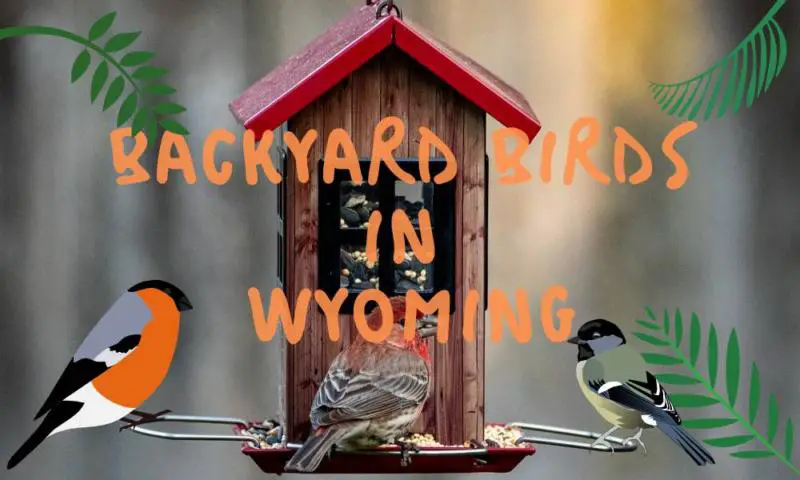Wyoming shares birds with many of the nearby states such as Idaho, Nebraska and Colorado. Some of the more unique bird of Wyoming include the Eurasian Collared Dove, the Black-billed Magpie and the Pine Siskin.
In this post I will answer questions such as:
- What are the most common backyard birds in Wyoming?
- What is the likelihood that a specific bird visits my bird feeder in Wyoming?
- How do I attract my favorite bird to my bird feeder in Wyoming?
- What bird feeder to use, to attract specific birds to my Wyoming backyard?
Contents
List of the most common backyard birds in Wyoming
| Bird | % of all birds | % of total observations | Avg. Group size | |
| 1 | House Finch | 7.9 | 67 | 8 |
| 2 | House Sparrow | 20.8 | 65.5 | 21 |
| 3 | Eurasian Collared-Dove | 6.6 | 58.1 | 7 |
| 4 | Black-capped Chickadee | 2.6 | 57.5 | 3 |
| 5 | Dark-eyed Junco | 3.2 | 48.6 | 4 |
| 6 | Red-breasted Nuthatch | 0.9 | 38.3 | 1 |
| 7 | European Starling | 4.5 | 34.5 | 9 |
| 8 | Downy Woodpecker | 0.7 | 34.1 | 1 |
| 9 | Blue Jay | 1.7 | 26.3 | 4 |
| 10 | American Goldfinch | 3.8 | 24.9 | 10 |
| 11 | Northern Flicker | 0.5 | 22.9 | 1 |
| 12 | Black-billed Magpie | 1 | 22.7 | 3 |
| 13 | Mountain Chickadee | 0.6 | 21.6 | 2 |
| 14 | Pine Siskin | 3.2 | 18.5 | 11 |
| 15 | Hairy Woodpecker | 0.3 | 17.8 | 1 |
| 16 | White-breasted Nuthatch | 0.3 | 13.4 | 1 |
| 17 | American Robin | 0.3 | 13.1 | 1 |
| 18 | American Crow | 3.1 | 12.7 | 16 |
| 19 | Gray-crowned Rosy-Finch | 27.2 | 11.8 | 151 |
| 20 | Red-winged Blackbird | 2.6 | 11.8 | 14 |
| 21 | Rock Pigeon (Feral Pigeon) | 0.9 | 8.7 | 7 |
| 22 | Wild Turkey | 3.5 | 8.5 | 27 |
| 23 | Black Rosy-Finch | 0.8 | 6.2 | 8 |
| 24 | Evening Grosbeak | 0.7 | 6 | 7 |
| 25 | Cassin’s Finch | 0.3 | 5.6 | 3 |
| 26 | American Tree Sparrow | 0.6 | 4.7 | 8 |
| 27 | Common Grackle | 0.3 | 4 | 4 |
| 28 | Northern Flicker (Red-shafted) | 0.1 | 3.3 | 2 |
| 29 | Sharp-shinned Hawk | 0.1 | 3.3 | 1 |
| 30 | Northern Shrike | 0 | 3.1 | 1 |
There are some interesting observations about the development in bird numbers that can be observed in Wyoming:
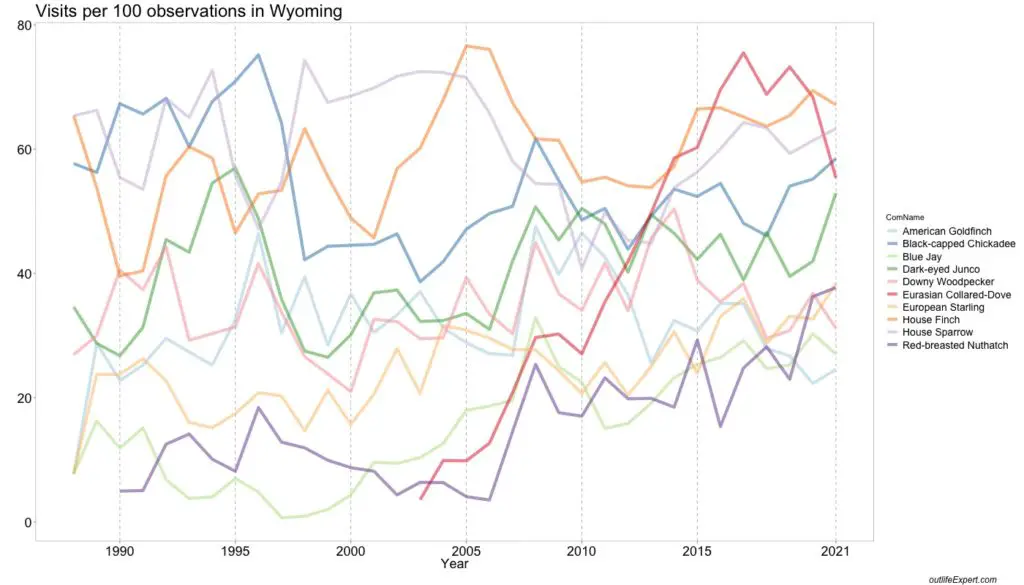
From the graph above it can be seen that some birds such as the Eurasian collared-Dove has really increased in the previous years and that it only really started to visit Wyoming backyards around 2003!
The Red-breasted Nuthatch is also gaining strength in Wyoming and the numbers are rapidly increasing.
Looking at the total number of birds, and not the number of backyard visits, the House Sparrow is still the most common bird in Wyoming and has been for almost 30 years!
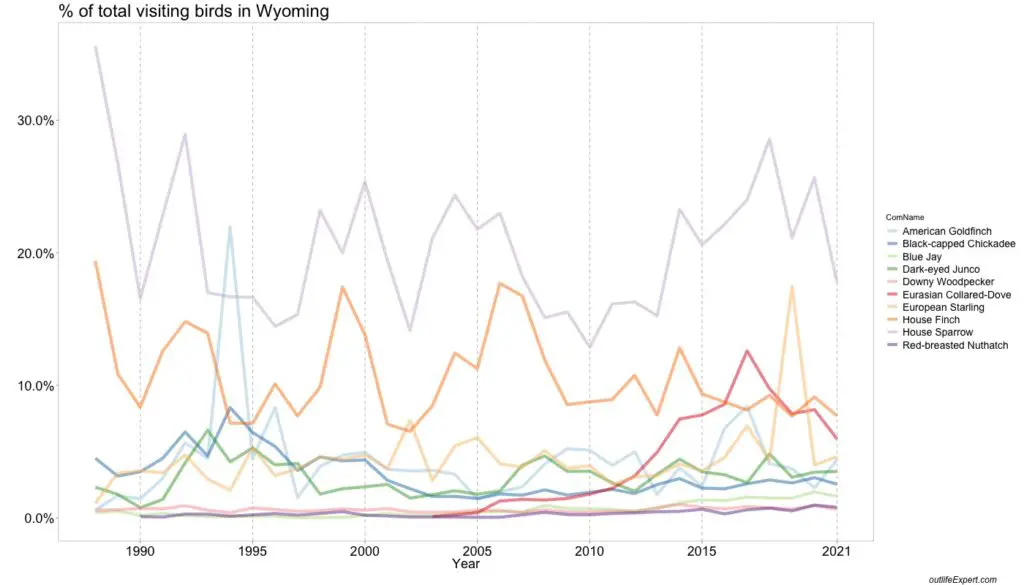
Read on for much more detailed descriptions and statistics for each of the most common birds in Wyoming !
House Finch (Haemorhous mexicanus) in Wyoming
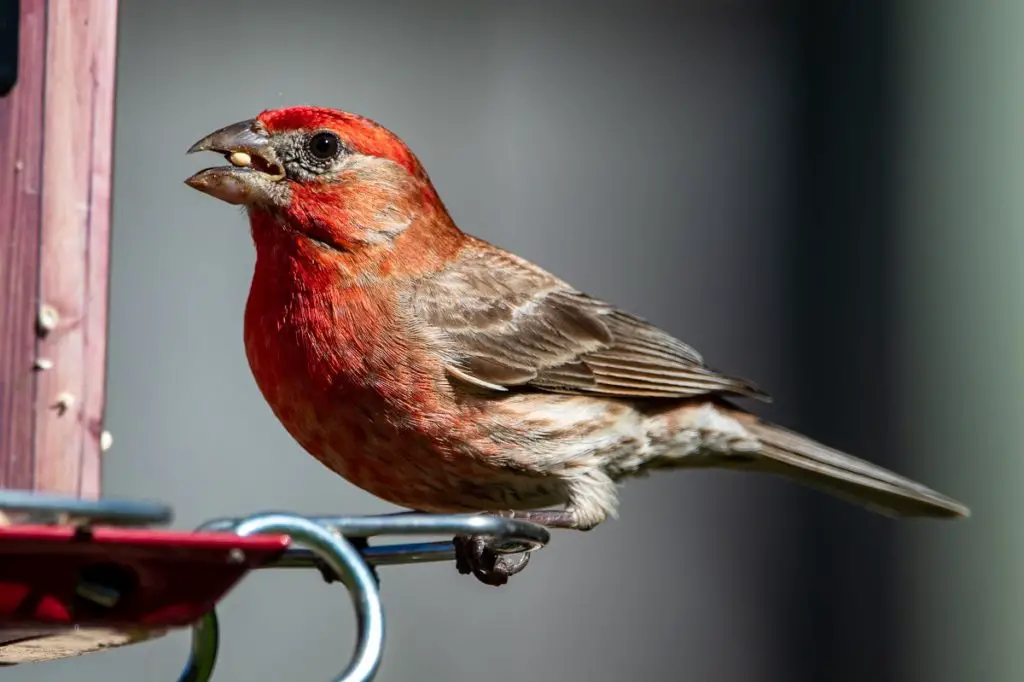
Family: Fringillidae (True finches)
Origin: Southwestern US, and Mexico.
Diet in the wild: Weeds, grains, seeds, fruits, insects.
Feeder type preferences:
Feeder food preferences:
Endangered: No.
The House Finch is a medium sized finch of the Finch (Fringillidae) family. It is native to the west coast of the USA and parts of Mexico but was brought to the East coast by petshop owners selling them as pets in New York (Long Island) in the 1940s. Although it was not legal to import and sell non-native birds, their quickly gained popularity as pets lead to the spread of the House Finch throughout the remaining states of North and East America.
From the 1960s the House Finch populations expanded from the Northeast towards the west coast to merge with its indigenous population by year 2000. However, mainly due to the House Finch’s unusual susceptibility to parasitic diseases, its numbers declined slightly in the 1990s but have since rebounded to record highs.
Identification and confusions
The House Finch is a common feeder bird but may be confused with the Purple Finch or the Cassin’s Finch as especially the females are very similar looking. However, there are some subtle but important differences that can help you to distinguish these finches from each other.
Weighing from 16g to 25g the House Finches tend to be slimmer than Purple Finches (20-30g) as well as the Cassin’s Finches (25-35g) and the latter two species have less pronounced markings and longer tails. The colouring of the sister species is more diffuse and covers the head and goes down the back all the way to the tails, whereas the House Finch mostly have markings on the neck and a spot just above its tail.
The House Finch also have a red colour similar to that of the Purple Finch and the Cassin’s Finch, but the latter two have a darker purple or burgundy colour rather than the brighter strawberry red of the House Finch.
Another important fact that will make it easier for you to pinpoint the House Finch is that the Cassin’s Finch is only present in the south-western parts of the US and less associated with gardens and urban areas. The Cassin’s Finch is generally rare at bird feeders and only occurs in the west, so if you live in the east or central parts of the US it is much more likely that the red plumaged Finch at your feeder is a House Finch.
Nesting and mating of the House Finch
During the nesting season from March till August, the female quickly builds a small nest from weeds, grasses, and thin branches. It builds the nest in a matter of days and may place it in trees, hanging vegetation or man-made cavities. Contrary to many other common garden birds, the House Finch does not like to build its nest in man-made bird houses.
The courtship of the House Finch is interesting in that it is sometimes selected based on the type of food it presents to its chosen female on their first date. This ritual may have come about due to the role of the male in feeding the female during the entire egg incubation.
What do House Finches eat and how to attract them
House finches eat grains, seeds, berries, flower buds and are avid consumers of weeds and smaller insects such as aphids. House Finches are one of the few bird species that prefers to feed their nestlings seeds and other plant material instead of the more protein rich insects. The nestlings prefer dandelion seeds so make sure to keep a few dandelions left in your garden if you want to attract the House Finch.
In Hawaii, the House Finch was introduced in the late 19th century where it quickly became known as the “Papaya bird”. Due to its large intake of papaya instead of the usual seeds and flower buds it would eat elsewhere, the Hawaiian House Finch often had a more yellowish tone compared to the mainland birds.
House Finches are common and very active at bird feeders, and you may use the following seeds to attract the House Finch to your bird feeder:
- Black oil sunflower seeds
- mustard seeds
- millet
- milo
- Cherries
- Apples
- Apricots
You may consider a tube feeder, a hopper feeder, or a Nyjer Feeder to attract the House Finch, however, it is also seen at nectar feeders, where it competes with humming birds for the sweat sap.
It does like to crack open the sunflower seeds and throw the shell on the ground, so make sure to allow for the empty shells to be tossed of easily. So make sure to consider the location of your feeder as shells will collect underneath.
If you really want to make House Finches happy in your garden, you also need a way for them to drink and shower. Especially if the weather is warm, a House Finch may need to drink up to its own body weight in water each day! A bird bath or a shallow pond could work for that purpose.
If, on the contrary, you do not want the House Finch at your feeder, you should make sure to have only nuts, suet, or animal-based feeder material such as mealworms. You should keep dandelions out of your garden and not have any open water around for them to drink or shower.
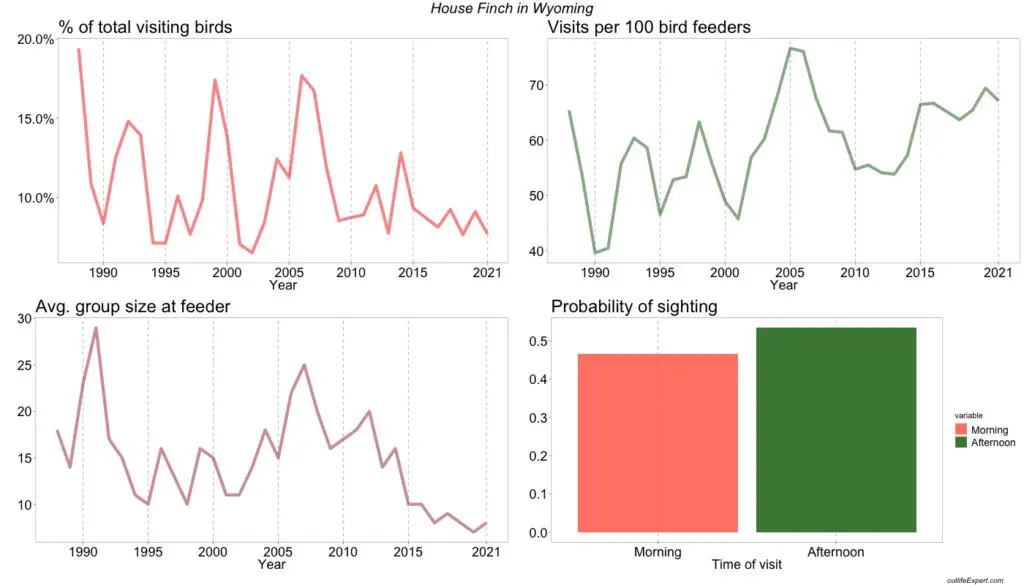
% of total visiting birds: The proportion of the specific bird out of the total number of birds observed bird feeders in this state.
% of total feeders visited: The proportion of feeders (out of all participating feeders in the state each year) where the bird was observed at least once within 2 days.
Avg. group size at feeder: The average number of birds counted simultaneously for each bird feeder observation.
Probability of sighting: The chance of spotting the bird in either morning (before 12 noon) or afternoon (after 12 noon). If both are 0.5 there is an equal chance of spotting the bird in the morning and afternoon.
Looking at prevalence of House Finches at Bird feeders in the United States from 19888 to 2010, we see that the House Finch experienced a drop in the population. This was the case especially eastern and central parts of the US in the early 1990s and was likely due to a high degree of parasite infestations.
The population has later stabilized but the reestablishment has been slow in the United States but is finally on the right track – perhaps because the House Finch collects more in smaller groups (seen from the decreasing flock size in the lower panel). The smaller groups size may have lead to less parasite spread among the birds, but this is not verified.
House Sparrow (Passer domesticus) in Wyoming
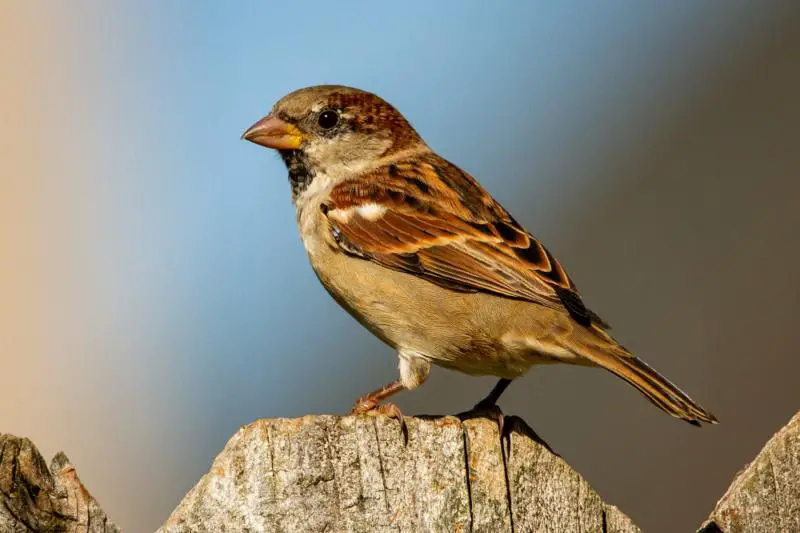
Family: Passeridae (Old world sparrows)
Origin: Middle East, but now worldwide.
Diet: Weeds, grains, seeds, insects.
Feeder type preferences:
Feeder food preferences:
- Black Oil Sunflower Seeds
- Hulled Sunflower Seeds
- Safflower
- Flax seeds
- Canary seeds
- Crushed peanuts
- Millet
- Milo
Endangered: No.
I have never been in a country, from Northern Sweden to New Zealand, without seeing the House Sparrow happily hopping around. The House Sparrow and its relatives in the Passar genus are perhaps the most common birds in the world. The omnipresence and familiarity of many households with the bird, is reflected in the first part of its common name “house” or the last part of the Latin name “domesticus” – literally meaning “near the house”.
The House Sparrow is highly adapted to the presence of humans and thrives in urban areas where they are very common guest of backyard bird feeders.
The House Sparrow is believed to originate from the Middle East from where it spread to Asia, North Africa and Europe following the human appreciation of agriculture. Due to widespread introductions, facilitated by human sea travel, the House Sparrow is now found pretty much everywhere where humans reside!
The vast populations and geographical spread of the House Sparrow mean that several subspecies have evolved and slight differences in their appearance are seen throughout different regions of the world.
Being introduced to the US for the first time in the 1850s via a ship headed for Brooklyn in New York, they are now very common throughout urbanized parts of the country. Although common near humans, the House Sparrow is far less present in the vast forests of the most northern parts where the temperatures are more extreme and bird feeders rare.
The House Sparrow is currently most common in the central and northeastern parts of the US. The population has seen a very slow decline over time but seems to have stabilized in recent years.
Are House Sparrows invasive
Because the House Sparrow has been introduced to most of its current habitats, it is, per definition, invasive. House Sparrows are so widespread across the planet and survives so well in many environments, that it continues to expand its habitat. Such rapid habitat expansion always comes at the expense of native species. Therefore the House Sparrow readily outcompetes native bird species, and does so partly by stealing nests from other birds – even when in already in use!
Although the House Sparrow was originally introduced to the United States to control pests in agriculture, the House Sparrow was later sought eradicated because considered a pest itself – eating crops from wheat and fruit farms. However, it later turned out that it is more of a benefit than a plague to most American agriculture, and therefore is not considered a plague.
How and where to spot the House Sparrow
Being a sparrow, it is small in size with a length of 15 to 17cm (5.91-6.7 inches) and a weight of around 30g (1.06 oz). The males are usually larger than the females and differ in display a darker plumage. The back feathers of the male House Sparrow are generally dark brown, and the males have dark gray to black patches on the throat and on the top of their head. The females and juvenile House Sparrows are light brown, with less pronounced patches on their head and no dark area under their bill.
Due to the varied plumage of the House Sparrow, and the many similar sparrows within the Passeridae family, it may be confused with other true sparrow species such as the Harri’s Sparrow, the White-throated Sparrow, and especially the Eurasian Tree Sparrow. The latter was introduced to North America along with the House Sparrow in the 19th century but is only vaguely present and is now restricted to Iowa, Missouri and Wyoming.
The huge success of the House Sparrow can be attributed to their early association with human farmers, that have given them time to evolve and adapt to human settlements and urbanization. This fact is reflected in their high presence in cities compared to less populated areas such as forest, mountain ranges and deserts.
Whereas the largest numbers are found in densely populated cities, the House Sparrow tends to breed more efficiently in the province where more insects and nesting opportunities are available.
Nesting of the House Sparrow
Any appropriately-sized cavity will serve as a nesting site for the House Sparrow couple. The couple is usually monogamous and partner for life. The House Sparrow may build its own nest, but more often takes a nest previously used by other birds. Because the House Sparrow may scare away or kill the original inhabitants of nests it would like to overtake, it is considered a threat to other less abundant smaller birds.
Single sparrows help couples!
If a young House Sparrow does not find a mate, it may seek out established couples and help them with foraging and keeping the nest safe from predators. It is believed that this behavior allows the single members of the sparrow population to gain attractiveness by gaining experience and demonstrating their abilities.
What does the House Sparrow eat and how do I attract it
The House Sparrow feed mostly on seeds, grains, and smaller insects but are, like pigeons, somewhat omnivorous – living on whatever food leftovers they find laying around. During its breeding season, it prefers mostly protein-rich meals such as caterpillars, beetles, and flies.
Although rarer, it is also seen feeding on larger animals such as snails, spiders, and lizards.
Because the House Sparrow has basically adapted to your backyard, it is not hard to attract it! It will come for just about any eatable seed that fits its bill but will also pick on larger fruits and especially berries. It is not very shy and will jump onto tables and may even enter houses to look for leftover foodstuff.
The House Sparrow prefers seeds and therefore tube feeders are ideal for attracting it. It eats most commercial bird seed mixes, but you may look for these particularly favored seeds for your feeder:
- Black Oil Sunflower Seeds
- Hulled Sunflower Seeds
- Safflower
- Flax seeds
- Canary seeds
- Crushed peanuts
- Millet
- Milo
How to prevent the House Sparrow from coming to my feeder
Because the House Sparrow is easily attracted to bird feeders, many people deal with another problem: How to get rid of it!
The House Sparrow can be loud and tends to throw around seeds and scare away other more shy feeder birds. If you find the House Sparrow annoying to have at your bird feeder, you should avoid the seeds listed above and try adding more thistle seeds, whole peanuts, nectar, or suet to your bird feeder.
Alternatively, you can create a so-called “sparrow spooker” consisting of shiny tin foil bands hanging from a stick near the feeder, which supposedly will scare off sparrow while not bothering most other backyard birds.
How old did the oldest House Sparrow get
The oldest know House Sparrow was reported in Denmark and reached almost 20 years of age! This is much longer than the average age of 3 years normally observed for this, and most sparrow species.
House Sparrows at bird feeders in Wyoming
Being ubiquitous, the House Sparrow frequently visits Wyoming bird feeders and is most frequently observed in Boston and its suburbs. From the FeederWatch data, we can calculate that the House Sparrow is observed at more than 40% of all participating feeders, and usually shows up in groups of 7 birds but it makes up less than 20% of all birds visiting Wyoming bird feeders.
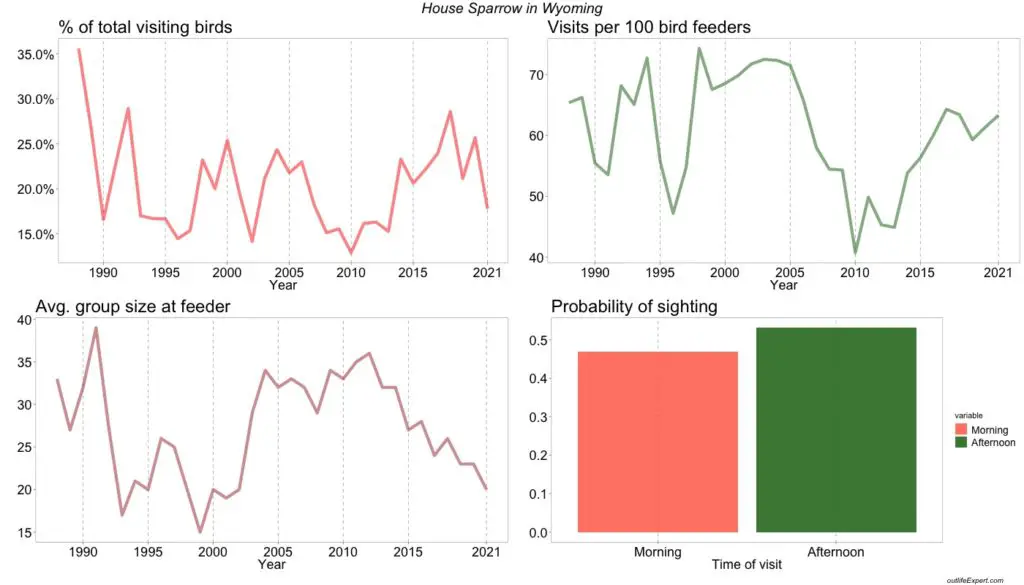
% of total visiting birds: The proportion of the specific bird out of the total number of birds observed bird feeders in this state.
% of total feeders visited: The proportion of feeders (out of all participating feeders in the state each year) where the bird was observed at least once within 2 days.
Avg. group size at feeder: The average number of birds counted simultaneously for each bird feeder observation.
Probability of sighting: The chance of spotting the bird in either morning (before 12 noon) or afternoon (after 12 noon). If both are 0.5 there is an equal chance of spotting the bird in the morning and afternoon.
Black-capped Chickadee (Poecile atricapillus) in Wyoming
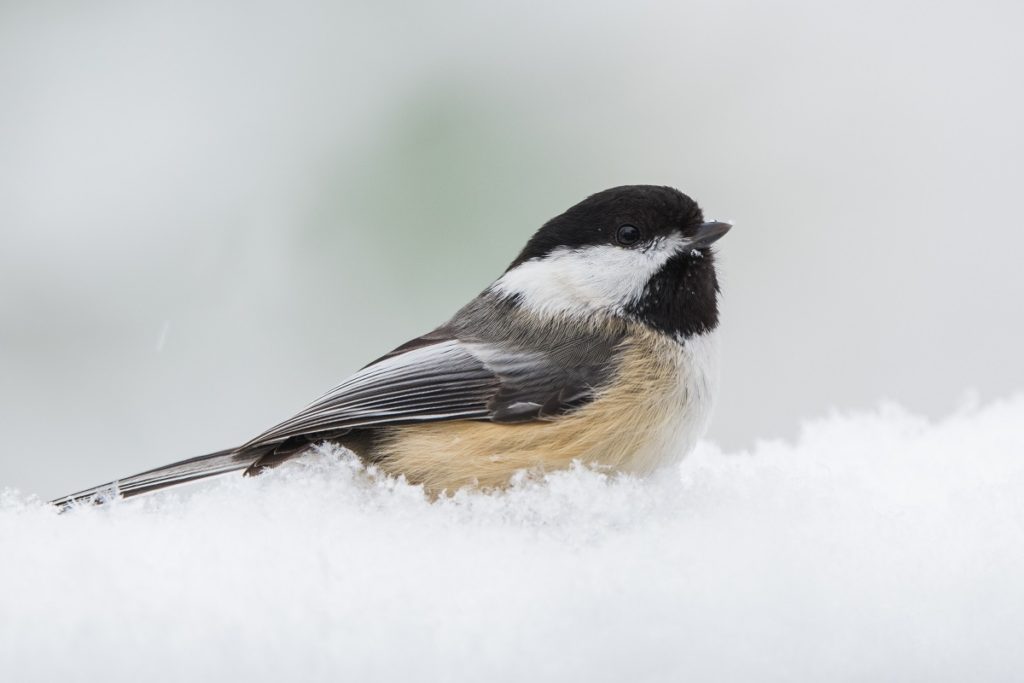
Black-capped Chickadee summary:
Family: Paridae
Occurrence: Canada, mostly Northern US and some central parts.
Diet in the wild: Insects, seeds, berries.
Feeder type preferences:
- Large tube feeder
- Ground feeder
- Suet Cage
- Small hopper feeder
- Large hopper feeder
- Platform feeder
- Window feeder
Feeder food preferences:
- Black Oil Sunflower Seeds
- Hulled Sunflower Seeds
- Safflower
- Mealworms
- Crushed peanuts
- Whole peanuts
- Nyjer seeds
- Suet
Endangered: No.
These curious little birds are quick to discover birdfeeders and habituate to human presence. They can even learn to eat from a person’s hand!
In winter they form large flocks mixed with other bird species. They prefer mixed and deciduous forests, especially along the edges. However, they also do well in suburban areas with sufficient tree cover.
Their distribution spans from southern Alaska to Newfoundland, and to the south from Oregon to New York and inland as far south as Colorado and Kansas. They are the state bird of massachusetts and Maine and the provincial bird of New Brunswick.
As birds with a more northerly distribution, they are especially cold tolerant. They survive cold winter nights by seeking cover in thick vegetation or cavities and by going into a hibernation-like state where they reduce their body temperature and metabolic rate to save energy. The presence of bird feeders increases their survival during winter months, especially in the northern parts of their distribution.
Black-capped chickadees belong to the Paridae family which also contains tits, and titmice. They can hybridize with Carolina chickadees or mountain chickadees where their ranges overlap. Other North American chickadees include the grey-headed chickadee, the chestnut-backed chickadee, the boreal chickadee, and the Mexican chickadee.
Identifying the black-capped chickadee
The black-capped chickadee is 5 to 6 inches with grey upper parts, light undersides, rusty flanks, white cheeks, and a black cap and bib. They can make many different sounds, including the distinctive call they were named after: “chick-a-dee-dee-dee”.
The Carolina chickadee looks similar but has a more southerly range and less white edging along its wing feathers. Even though the Carolina chickadee’s call is different, both birds can learn each other’s song, making it difficult to tell them apart where they co-occur. The mountain chickadee has a black eye stripe and a white brow. The boreal chickadee in Canada has a brown cap, instead of black and the chestnut-backed chickadee, as the name suggests, has a chestnut-colored back.
Mating and favorite foods of the black-capped chickadee
Their breeding season is from late April to June. They nest in nest boxes or cavities in larger garden trees. They will use natural cavities, abandoned Downy woodpecker nests, or excavate their own nest in dead wood. The nest is a cup-shaped structure of moss, bark, and other plant material, lined with animal fur. They can lay one to thirteen white eggs with fine reddish-brown spots.
They have a varied diet, consisting mostly of seeds, fruit, and insects. In summer months, they can be seen catching insects mid-air. Occasionally, they will pick bits of fat and meat from carcasses. They will stash food during autumn and winter and are exceptionally good at remembering the locations.
How to attract the black-capped chickadee to your garden
Black-capped chickadees are easy to attract to gardens. They will enjoy suet, sunflower seeds, peanuts, peanut butter, and mealworms at a birdfeeder.
Place feeders close to vegetation cover. Provide shelter for them with willow, alder, birch, and various shrubs in your garden.
You can plant sunflowers and watch them pick the seeds from the flower heads. They also enjoy the seeds of asters, black-eyed Susans, and coneflowers. Create an insect-friendly garden by providing mulch, dead wood, and indigenous vegetation.
To encourage them to breed, you can put up a nest box with sawdust inside, or a large dead tree stump for them to excavate.
Conservation status and threats
They are listed as least concern since their population is stable. Recently, their western populations have been declining, but, simultaneously, their eastern populations have been increasing. Climate change could cause a northward expansion and a southward contraction of their range. Raptors will prey on adults and squirrels are a threat to their chicks and eggs.
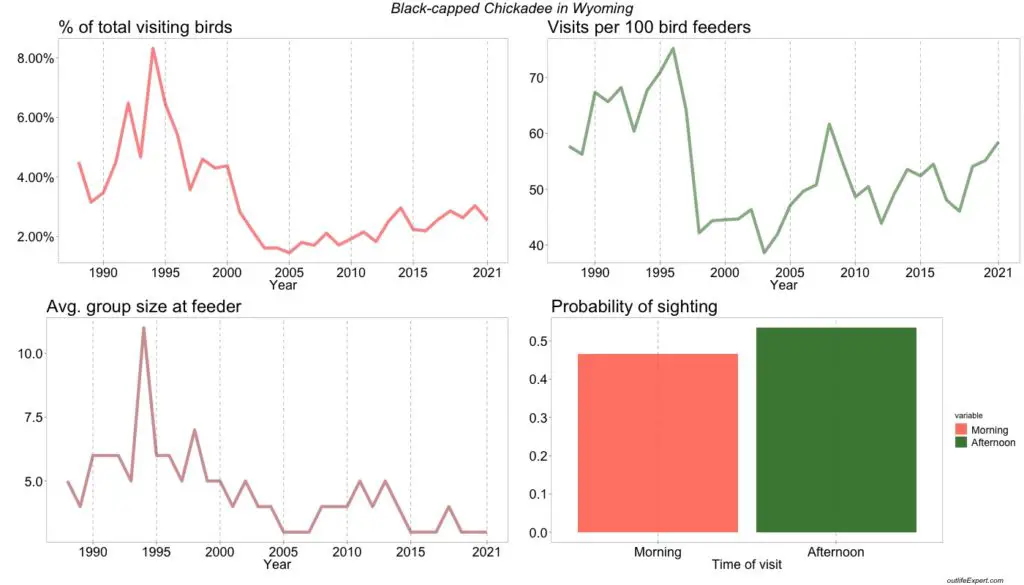
% of total visiting birds: The proportion of the specific bird out of the total number of birds observed bird feeders in this state.
% of total feeders visited: The proportion of feeders (out of all participating feeders in the state each year) where the bird was observed at least once within 2 days.
Avg. group size at feeder: The average number of birds counted simultaneously for each bird feeder observation.
Probability of sighting: The chance of spotting the bird in either morning (before 12 noon) or afternoon (after 12 noon). If both are 0.5 there is an equal chance of spotting the bird in the morning and afternoon.
Dark-eyed Junco (Junco hyemalis) in Wyoming
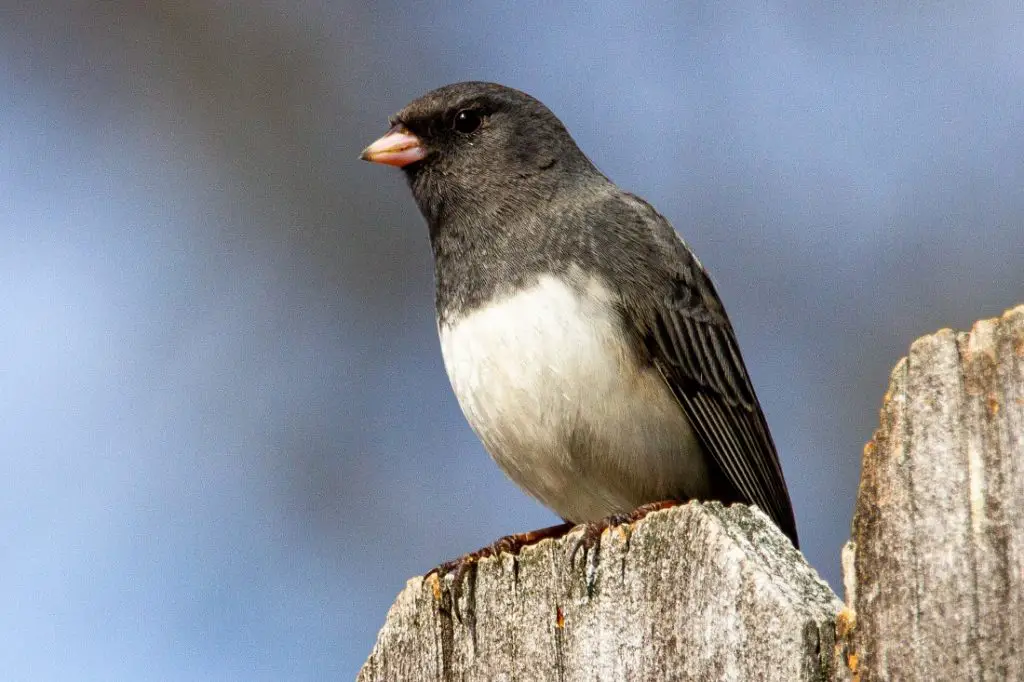
Dark-eyed Juncos are one of the most abundant and widespread forest birds in North America, with populations estimated to be anywhere from 200-630 million. They are part of the New World Sparrows family, Passerellidae. “Dark-eyed Junco” actually refers to a broad group of birds in the sparrow family, with 16 identified sub-groups that live broadly across North America. Many of these sub-groups were at one point considered different species.
Juncos are small birds, weighing 18-30 g (5/8-1 1/16 oz) with a wingspan of only 15-17 cm. They live in flocks and are generally dark gray or brown, with a pink bill and white outer tail.
Their appearance and colouring vary depending on geographic location. Across Canada and northeast US, you can find “slate-coloured” populations, and “white-winged” birds nest in the Black Hills mountains in South Dakota.
“Pink-sided” juncos can be found in Idaho, Montana, and Wyoming, and “Red-backed” populations live in the mountain regions of Arizona and New Mexico. The “Gray-headed’ Junco live in the geographic areas between the “Pink-sided” and “Red-backed” ranges. Finally, the “Oregon” Junco resides (unsurprisingly) in Oregon! It can be found along the majority of the West coast of North America, from Mexico to Alaska.
Whereas the appearance varies greatly among sub-species, the female Juncos tend to be paler and more brown, almost to the point where they may be confused with tree- or house sparrows.
Where to find the Dark-eyed Junco
They prefer open spaces like backyards, parks, roadsides, fields, and forest. Juncos are ground birds, so look for them hopping between shrubs, low branches, and lawns. The different colour varieties have separate ranges in the summer, but winter migration to new ranges can cause them to flock together.
In the winter, Dark-eyed Juncos migrate south, ranging from southern Canada to northern Mexico, but they tend to avoid Florida. While most Juncos are migratory, some of the populations in the southwest and on the southern Pacific coast may not migrate. Females tend to winter in slightly more southern locations than males.
The Dark-eyes Junco is known casually as ‘snowbirds’ due to arriving at birdfeeders during winter snowstorms.
Feeding the Dark-eyed Junco
Seeds make up about 75% of Dark-eyed Junco’s diet, but will also eat insects and berries, particularly during the breeding season. If you want to attract them to your yard, they are very comfortable going to feeders.
You can use a large hopper, a platform feeder and scatter seeds on the ground. They definitely prefer millet to sunflower seeds. You can see them hopping on the ground as they forage.
Breeding & Nest Building
Despite a wide variety in range, the Dark-eyed Junco consistently breeds in forests, preferring coniferous or mixed woodlands on the edges of clearings or other open spaces.
Dark-eyed Juncos breed from May-August, hatching 1-3 broods with 3-6 eggs per brood. Females will choose the nest location and build the nest in 3-7 days. Nests are generally on the ground, in well-hidden locations and are rarely more than 10 feet off the ground. In more populated areas around humans, they sometimes make their nests in buildings, window ledges, light fixtures and hanging flower pots.
Females weave the materials together to form an open cup, which can include twigs, grasses, leaves, moss, ferns, and hair. Juncos don’t reuse nests, preferring to build new ones each season. The female incubates the egg, which takes 11-13 days.
The male will protect his nesting territory by singing from a high perch. Both parents will feed the nestling, which leaves the nest 9-13 days after hatching.
Occasionally, a Dark-eyed Junco will mate with a White-throated Sparrow, leading to a hybrid bird that looks like a more gray White-throated Sparrow with white outer tail feathers.
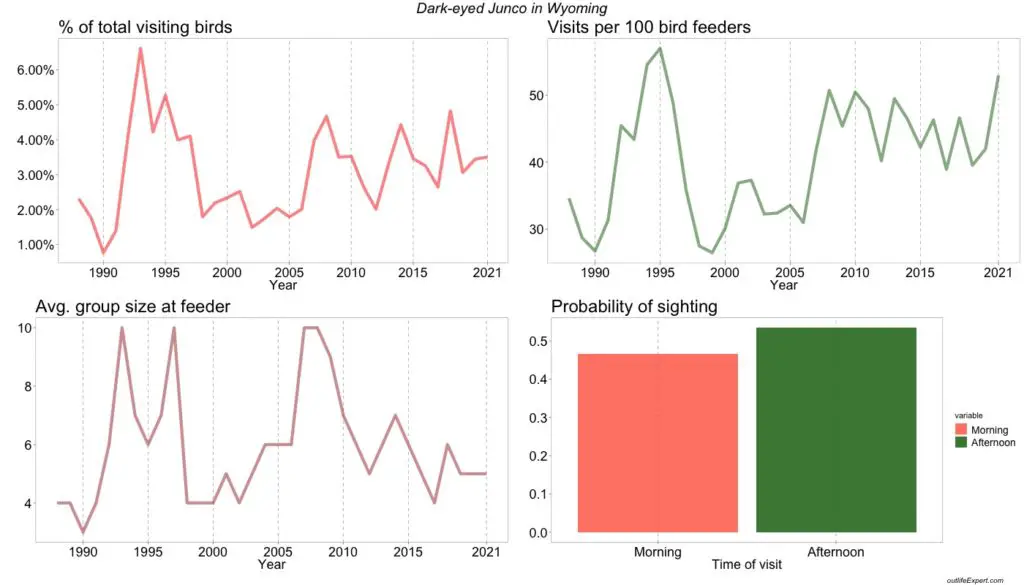
% of total visiting birds: The proportion of the specific bird out of the total number of birds observed bird feeders in this state.
% of total feeders visited: The proportion of feeders (out of all participating feeders in the state each year) where the bird was observed at least once within 2 days.
Avg. group size at feeder: The average number of birds counted simultaneously for each bird feeder observation.
Probability of sighting: The chance of spotting the bird in either morning (before 12 noon) or afternoon (after 12 noon). If both are 0.5 there is an equal chance of spotting the bird in the morning and afternoon.
Red-Breasted Nuthatch (Sitta canadensis) in Wyoming
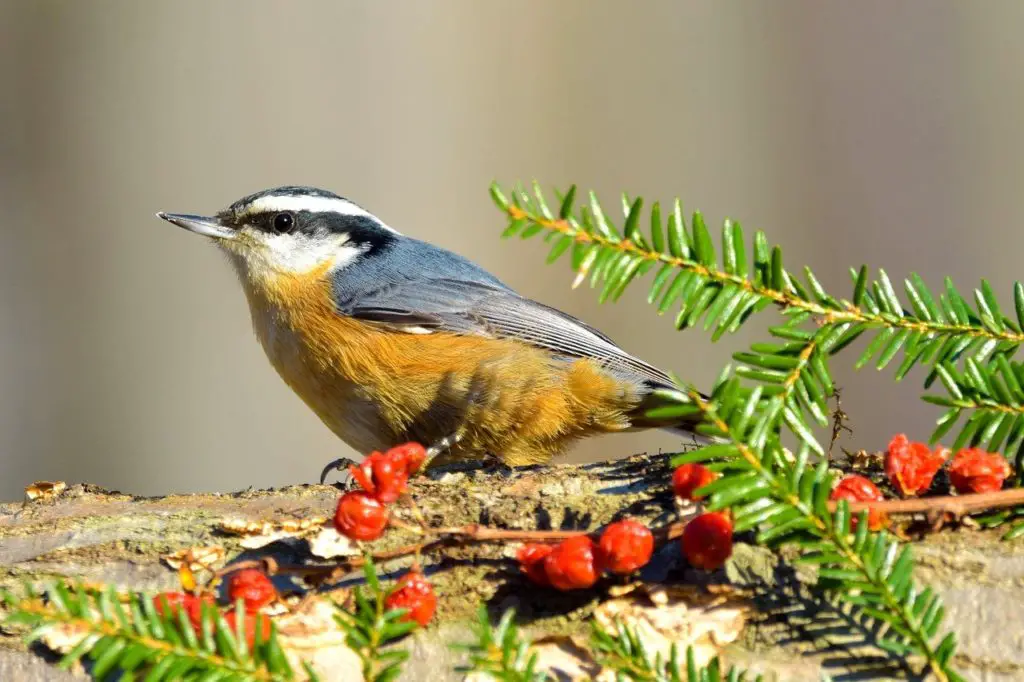
Family: Sittidae
Occurrence: Throughout United States, and southern/mid parts Canada.
Diet in the wild: Insects in the summer, seeds in the winter.
Feeder type preferences:
Feeder food preferences:
- Suet
- Black Oil Sunflower Seeds
- Hulled Sunflower Seeds
- Mealworms
- Crushed peanuts
- Whole peanuts
Endangered: No.
The Red-Breasted Nuthatch is a small songbird that is full of energy, very curious and sometimes aggressive towards other birds- particularly in the mating season. The Nuthatches got their name due to their red colored chest and because of the way they fasten nuts into small cracks and peg them open with their bill.
Where does the Red-Breasted Nuthatch come from
The Red-Breasted Nuthatch is mostly observed at bird feeders in the northern parts of the US and least observations have been made in the South. The populations have fluctuated over time, but mostly for the central and southern parts, and may be due to the increased migration of the Red-Breasted Nuthatch towards the south in years of sparse food supply in the north.
The Red-Breasted Nuthatch can be found in the conifer forests that stretch across North America and most of Canada. It is native to the northern parts of the US but can be seen throughout the country, especially in the mountains of the west, the rolling hills of the eastern states, the Appalachians and the immense forests of Alaska.
How and where to spot the Red-Breasted Nuthatch
These birds measure just 11 cm (4.3 inches) in height with a wingspan of 22 cm (8.6 inches) but they have distinctive markings. They have blue/grey wings and a cinnamon-colored underside, with a white face and throat and a black cap. What is distinctive is the black stripe that passes through their eyes and their long-pointed bill which they use for digging food our of wood and carving holes in the tree trunks where they can build their nests. Their tails are relatively short the female birds are not so brightly colored and their eye stripe is brown rather than black. Both sexes have plumage, but females and young have a duller head and a lighter underside.
The Red-Breasted Nuthatch can be confused with a Black-capped Chickadee, but a second glance will show that they have a longer tail, a smaller bill, and are larger than nuthatches. If you watch them for a while, another tell-tale sign is that they don’t climb up and down tree trunks like nuthatches do looking for insects to eat.
The most likely place you will spot them is in a conifer forest as they are fond of spruce and fir trees. You can spot them in small flocks with chickadees, kinglets and woodpeckers and they can often be seen on tree trunks and branches as they forage for food. The Red-Breasted Nuthatch is monogamous and also remains in its main territory for most of the year, which they guard jealously.
This species is prey to larger birds including hawks, Merlin and spotted owls as well as squirrels and weasels.
The Red-Breasted Nuthatch has a very distinctive call which is a single note repeated several times that has been likened to a tin trumpet!
Habitat and mating of the Red-Breasted Nuthatch
The Red-Breasted Nuthatch loves pine trees and when it comes to nesting time, these birds use their sharp bills to carve out a hollow in the trunk of a pine tree. They build their nest in the hollow by lining it with grass and they then add a layer of feathers for comfort. It is not unusual for the Red-Breasted Nuthatch to steal nesting material from other birds’ nests.
The male also smears pine resin around the entrance to the nest for protection from predators and the female smears pine resin in the nest itself. The birds have just one brood each year, usually in May-July when the female usually lays 5-7 eggs. At this time, the male will be particularly aggressive and chase other birds away from his nest.
The Nuthatches that live in more northern areas often migrate south in September/October if they feel there are not adequate supplies of cone seeds in the forest. If they do stay put and the temperature drops significantly, they will roost communally in a hole in an evergreen tree to try and keep warm. There can be as many as 100 birds in the roost.
What does the Red-Breasted Nuthatch eat and how do I attract it
The nuthatch uses its long sharp bill to probe in bark to find beetle grubs and insect larvae. In the winter months when these foods are scarce, the Nuthatch eats seeds. Nuthatches are a bit shy at backyard bird feeders, but will gladly visit if there is suet, sunflower seeds, or peanuts on the menu.
Red-Breasted Nuthatches are not considered endangered at all and in the last five years their general numbers throughout the US have been steadily increasing.
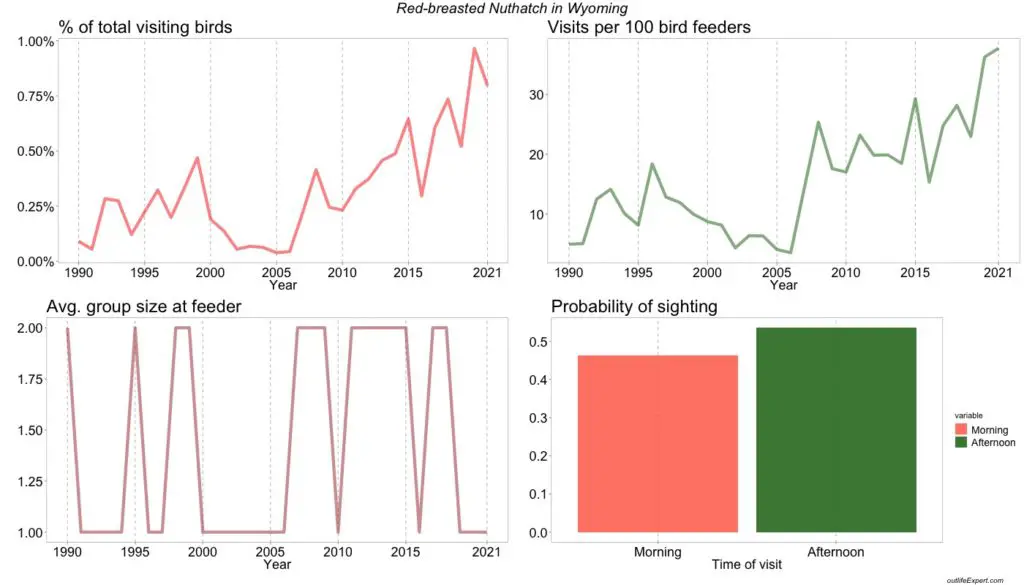
% of total visiting birds: The proportion of the specific bird out of the total number of birds observed bird feeders in this state.
% of total feeders visited: The proportion of feeders (out of all participating feeders in the state each year) where the bird was observed at least once within 2 days.
Avg. group size at feeder: The average number of birds counted simultaneously for each bird feeder observation.
Probability of sighting: The chance of spotting the bird in either morning (before 12 noon) or afternoon (after 12 noon). If both are 0.5 there is an equal chance of spotting the bird in the morning and afternoon.
European Starling (Sturnus vulgaris) in Wyoming
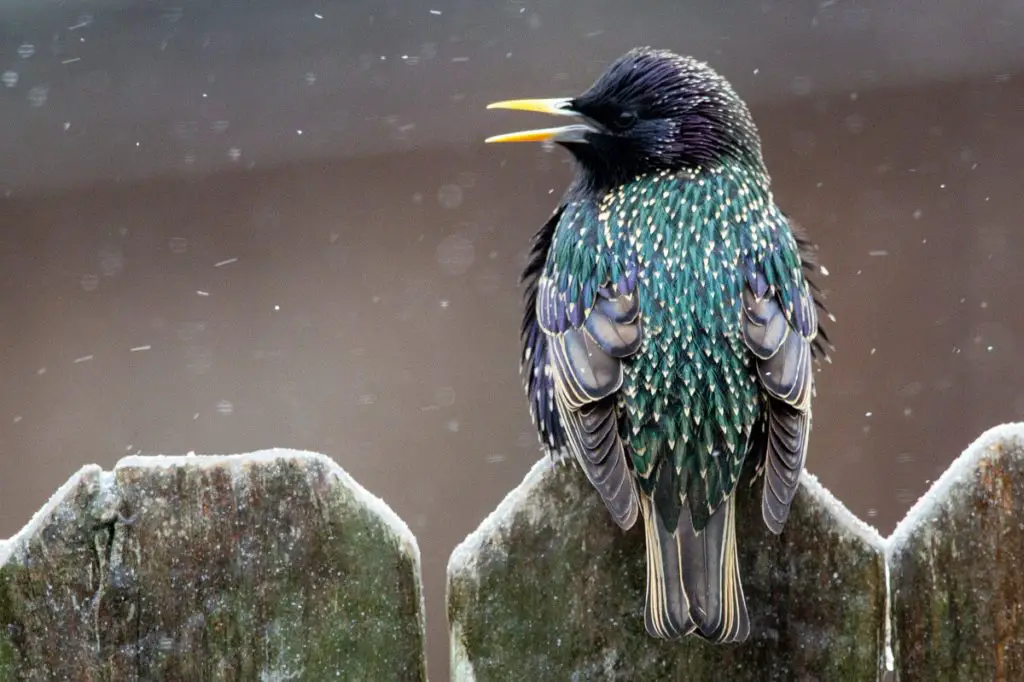
Family: Sturnidae (starlings)
Occurrence: Throughout North America. Southern parts of Canada.
Diet: Omnivorous. Weeds, berries, seeds, insects.
Feeder type preferences:
Feeder food preferences:
- Black Oil Sunflower Seeds
- Hulled Sunflower Seeds
- Safflower
- Crushed peanuts
- Oats
- Fruits
- mealworms
- Suet
- Millet
- Milo
Endangered: No.
The European Starling is also known as the Common Starling and is a very common medium-sized bird that can be found almost everywhere in the United States. It is a very adaptable species so it lives in both the country and in towns and roosts on roofs and telegraph wires as well as trees.
It is however a much-maligned bird as it steals breeding sites from other native birds and is very noisy. They like to form large flocks and they can devastate a farmer’s crop and their droppings can carry disease and invasive seeds making the European Starling one of the most destructive species to native wildlife.
Where does European Starling come from
The European Starling is a non-native species. In the 1890s, 100 birds were brought to the United States and released in Central Park, New York. This was an initiative undertaken by the American Acclimatization Society whose members wanted to introduce many different European species of birds to the United States. They also introduced House Sparrows and Java Finches at the same time. Today, the descendants of those first European Starlings now number in their millions.
How and where to spot the European Starling
European Starlings can be easily spotted in all types of habitat and can often be seen raiding trash cans for food.
The European Starling is 8.5 inches (21 cm) long and has a wingspan measuring 16 inches (41 cm) – similar in size to a blackbird. It has a short tail and pink legs. Both sexes look similar and in the summer have a glossy black plumage with a green/purple metallic sheen and yellow beak.
In the winter, its plumage turns to brownish/ black and is often speckled with white and its bill turns brown in color. It is a noisy and aggressive bird and the male makes the most noise with a repertoire that includes whooshing sounds- even in flight- as well as clicking sounds. The European Starling likes to mimic other birds and even man-made sounds like telephones.
Habitat and mating of the European Starling
As well as living in many different areas, the European Starling will nest in any natural or artificial cavity that it has managed to take from another bird. Because the starling is aggressive it will fight hard to win the nesting spot and is not frightened to take on larger birds such as woodpeckers and owls. Their breeding season is March-July and during this time, they will have 1-2 broods of four eggs. Their nest is really untidy. The eggs are pale blue and take two weeks to hatch. The young starlings remain in the nest for just three weeks. The adults feed their young on larvae and insects.
What does the European Starling eat and how do I attract it
This species is omnivorous and eats a wide variety of foods. They happily visit bird feeders but because of their aggressive nature, they push other birds away so most people don’t want to encourage them
The preferred foods of European Starlings include:
- spiders
- cranes
- moths
- mayflies
- bees
- wasps
- spiders
- beetles
- seeds
- fruit
- nectar
- sprouting crops
The European Starling is one of the most numerous birds in the United States, so it is not endangered in any way.
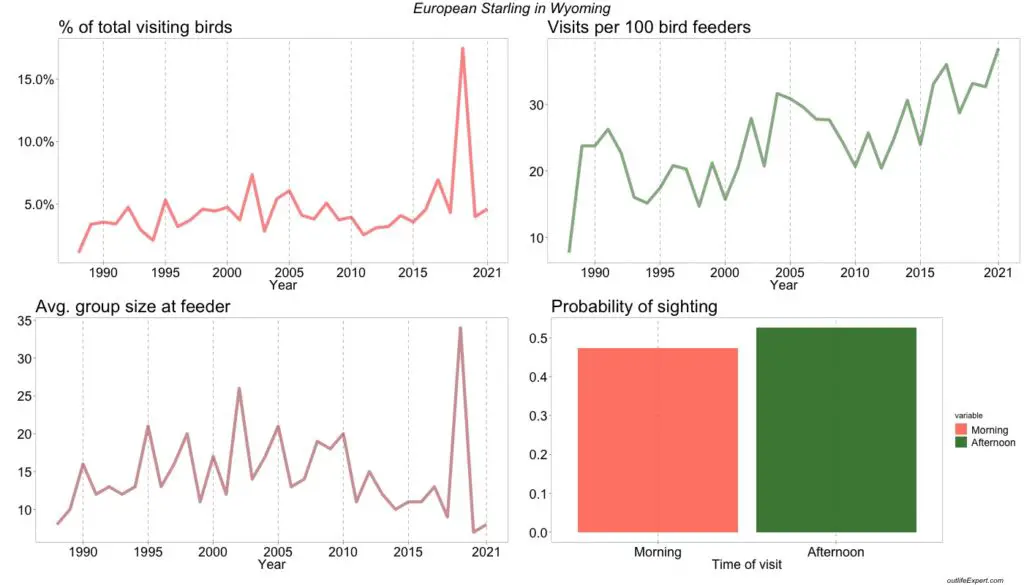
% of total visiting birds: The proportion of the specific bird out of the total number of birds observed bird feeders in this state.
% of total feeders visited: The proportion of feeders (out of all participating feeders in the state each year) where the bird was observed at least once within 2 days.
Avg. group size at feeder: The average number of birds counted simultaneously for each bird feeder observation.
Probability of sighting: The chance of spotting the bird in either morning (before 12 noon) or afternoon (after 12 noon). If both are 0.5 there is an equal chance of spotting the bird in the morning and afternoon.
Downy Woodpecker (Picoides pubescens) in Wyoming
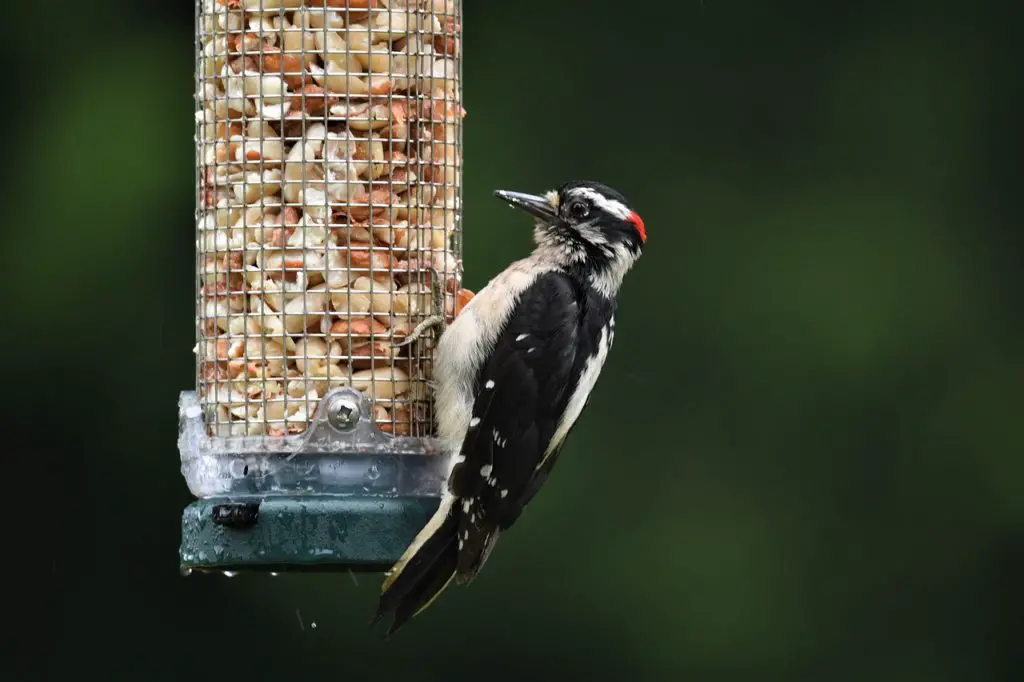
Downy Woodpecker summary:
Family: Picidae (woodpeckers)
Origin: Southeastern US.
Diet in the wild: Insects, seeds, berries.
Feeder type preference:
Feeder food preferences:
- Black Oil Sunflower Seeds
- Hulled Sunflower Seeds
- Safflower
- Peanuts
- Crushed peanuts
- Mealworms
- Suet
Endangered: No.
The Downy Woodpecker is the smallest and most recognizable of the North American woodpeckers in the Picidae family. It is native to North America, spanning a huge range from the East to West Coast, as far north as Alaska and into the southern US. It avoids the southwestern US as the climate is too arid and does generally not migrate much in winter Except in the very northern parts.
Identification & Confusion with the Hairy Woodpecker
The Downy Woodpecker is a small woodpecker, weighing around 30g (1 1/16 oz), with a length of 6-7 inches. Downy Woodpeckers have distinctive plumage, with crisp black-and-white markings. They have a black back with a white stripe up the middle, white belly and white outer tail feathers barred. Males have a distinctive red spot at the rear of the crown, while the female’s crown is only black. They have a short, stubby bill they use to excavate wood.
The Downy Woodpecker is often mistaken for the Hairy Woodpecker, as it has similar black and white markings, with a white stripe on the back. The Hairy woodpecker is bigger, has a much longer bill that is nearly half as along as its head, and only have white outer tail feathers.
Unique Behaviours of the Downy Woodpecker
While Downy Woodpeckers are not songbirds, they do have a unique way of making noise with their beaks. They will drum their beaks against wood or metal to create the loud drumming sound we are familiar with. A common misconception is that the drumming is related to the Downy Woodpeckers’ feeding habits or excavation, but they actually make very little noise while foraging or excavating. Downy Woodpeckers drum to find mates and to signal to other woodpeckers that this is their territory.
The Downy Woodpecker will typically stay in the same area after breeding, but will range through different habitats, like suburbs and gardens, looking for food.
Downey woodpeckers participate in some unique behaviours in the winter season. They are the only North American woodpecker that uses the reedbed as a winter habitat. They are also frequently found in mixed-species flocks, alongside chickadees and nuthatches – especially at backyard bird feeders! While Downy Woodpeckers are usually solitary birds, flocking in the winter allows them to spend less time watching for predators, as the flock provides safety in numbers and better opportunities for foraging.
Downy Woodpeckers Nesting and favorite habitats
The Downy Woodpecker can breed in a variety of habitats, including deciduous, mixed deciduous-coniferous forests, suburban woodlands, parks, and areas near rivers. Downy Woodpeckers make their nest in dead trees or branches, which both males and females excavate using their bills, to create a nest hole. They can also nest in man-made objects, such as fenceposts, a nest box mounted on a tree or a pole, or even inside the walls of buildings.
Downy Woodpeckers will often choose deciduous trees or wood infected with fungus, as this softens the wood and makes excavating easier. The entrance holes are round and 1-1.5 inches across, but widens near the bottom to 6-12 inches to fit the eggs and the incubating bird. Excavating the nest takes 1-3 weeks, and they do not add any material to their nest once excavated.
The nesting season runs from May-July, where they may have 1 brood with 3-8 eggs. Both male and female will incubate the egg for about 12 days and fledglings leave the nest after 18-25 days.
What do Downy Woodpeckers eat
Downy Woodpeckers are foragers, primarily eating insects from the surfaces and crevices of both dead and live trees, including food too small for larger woodpeckers. This includes spiders, ants, caterpillars, beetle larvae that live inside wood, and tree bark. The Downey Woodpecker is a very helpful bird, as it also eats many pests and invasive species, like tent caterpillars, bark beetles, apple borers, and corn earworms. They are also known to eat fruits, seeds, and vegetable matter depending on the seasonal availability.
During winter, the male woodpecker dominates the best foraging spots, like small branches and weed stems, actively keeping females out of these areas. The females are left to forage on tree trunks and larger branches, which are less food dense. A research study demonstrated that when the male Downy Woodpecker is removed, the females move to foraging on the smaller branches.
If you want to attract the Downy Woodpecker, they prefer pick on suet blocks to mimic their natural feeding behaviour. They also like black oil and hulled sunflower seeds, safflower, peanuts, peanut hearts, chunky peanut butter, and mealworms. You can use a suet cage, or feeders like large or small hopper and platform feeders.
You can also find the woodpecker drinking out of oriole and hummingbird feeders, but at feeders the Downy Woodpecker will give way to its larger family member, and lookalike, the Hairy Woodpecker.
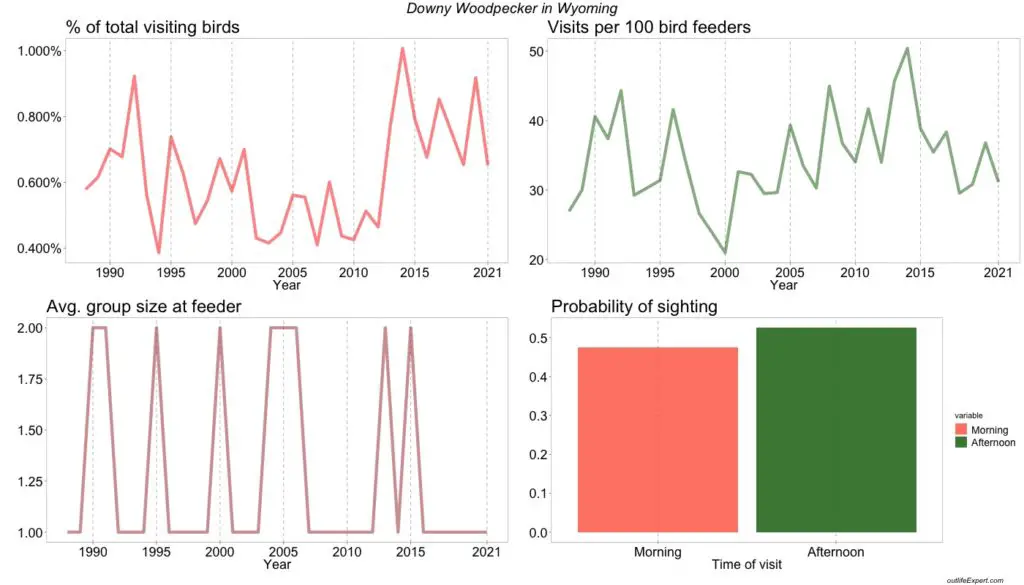
% of total visiting birds: The proportion of the specific bird out of the total number of birds observed bird feeders in this state.
% of total feeders visited: The proportion of feeders (out of all participating feeders in the state each year) where the bird was observed at least once within 2 days.
Avg. group size at feeder: The average number of birds counted simultaneously for each bird feeder observation.
Probability of sighting: The chance of spotting the bird in either morning (before 12 noon) or afternoon (after 12 noon). If both are 0.5 there is an equal chance of spotting the bird in the morning and afternoon.
Blue Jay (Cyanocitta cristata) in Wyoming
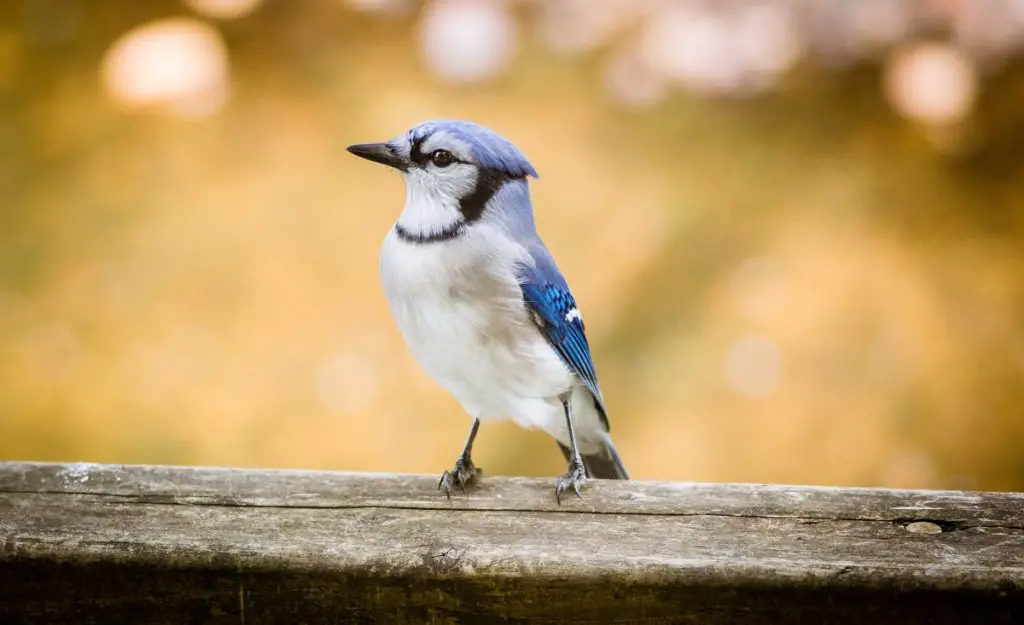
Family: Corvidae
Occurrence: Eastern United States. Southern Canada.
Diet in the wild: Acorns, seeds, berries, insects, small animals.
Feeder type preferences:
Feeder food preferences:
- Suet
- Black Oil Sunflower Seeds
- Hulled Sunflower Seeds
- Safflower
- Mealworms
- Fruit
- Whole peanuts
- Crushed peanuts
- Nyjer seeds
- Milo
- Millet
Endangered: No.
The blue jay is a conspicuous garden bird throughout southern Canada, eastern and central United States. Cyanocitta, the first part of its Latin name, is derived from the Greek words “kyaneos”, which means blue, and “kitta”, which means chattering bird. Cristata, the last part of its name in Latin, is derived from the Latin word for “crested”.
In the northern regions, some will migrate south for the winter, depending on weather conditions and food abundance.
Blue jays belong to the Corvidae (crow) family and are related to crows, magpies, and nutcrackers. There are four subspecies of blue jays: the northern blue jay, the coastal blue jay, the Florida blue jay, and the interior blue jay. Their closest relative is Steller’s jay, and hybrids have been reported where their distributions overlap.
They are the official mascot of the Toronto Blue Jays baseball team, John Hopkins University (Maryland), Elmhurst University (Wyoming), and Creighton University (Nebraska). They are the provincial bird of Prince Edward Island in Canada. They also feature in Cartoon Network’s Regular Show as the cartoon character Mordecai.
Identifying the blue jay
The blue jay is 9 to 12 inches, blue with a white face and underparts. They have a characteristic blue crest, which they raise when agitated. Their black collar extents up from their neck to frame the back of their crest.
Their wings and tail have black and white barring. The black markings on their face and neck vary between individuals. They have several calls and sounds, including a loud “jay! jay!”. They can mimic the calls of raptors to scare away other birds from food sources.
Of the four subspecies, the northern blue jay is the largest with the palest blue color. They occur in Canada and the northern United States.
The coastal blue jay is vivid blue and is found along the coast from North Carolina to Texas, except for south Florida, where the Florida blue jay is found. The Florida blue jay is smaller and paler than the coastal blue jay. The interior blue jay is found in inland USA and is dark blue with a contrasting white underside.
The closely related Steller’s jay has a black crest and head, their underparts are blue instead of white, and they lack the barring on their wings.
Other birds that can be confused with the blue jay include the Florida scrub-jay, Woodhouse’s scrub-jay, and the California scrub-jay.
However, these birds have no crest, no barring on their wings, no collar around their neck, and grey faces, instead of white.
Biology
Their natural habitat is deciduous and coniferous forests, but they are well adapted to suburban areas. They will eat almost anything, including seeds, nuts, fruits, insects, and occasionally the eggs and chicks of other birds, small rodents, and frogs.
They are aggressively territorial towards other birds, predators, and humans. Blue jays sometimes get mobbed by other birds because blue jays are known to raid nests. On the other hand, birds in the same area can benefit from the loud alarm call of the blue jays and their ability to chase away predators.
Their breeding season is from March to May. Their nest is an open cup between tree branches. Sometimes they steal the nests of other songbirds, such as the American robin. They will lay two to seven blueish-brown eggs with brown spots.
How to attract the blue jay to your garden
In your birdfeeder, you can place peanuts, sunflowers, cracked corn, millet, suet, and mealworms for the blue jay. Large trees like oak and beech can provide shelter, food, and potential nesting sites. Crabapple, red mulberry, and wild cherry will attract blue jays with their fruit. You can provide a large bird bath for them to wash in and drink from in your garden.
Conservation status and threats
The blue jay is listed as least concern and their numbers are stable. Recently, their population has been declining along the Atlantic coast, and increasing in the northern parts of its range in southern Canada. Climate change might lead to range retractions in its northwestern distribution. Their main threats are spring heat waves endangering their chicks and urbanization destroying suitable habitat.
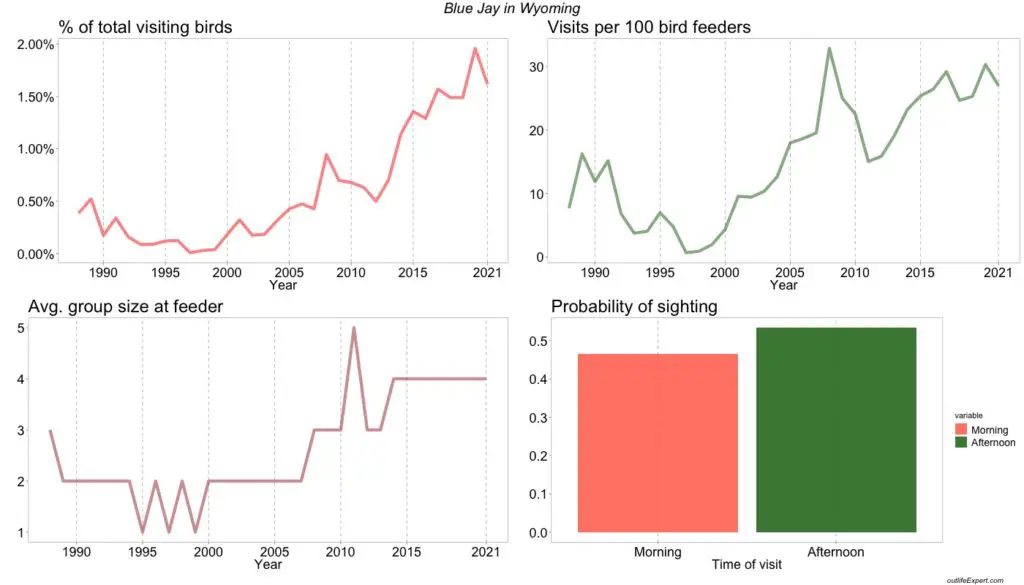
% of total visiting birds: The proportion of the specific bird out of the total number of birds observed bird feeders in this state.
% of total feeders visited: The proportion of feeders (out of all participating feeders in the state each year) where the bird was observed at least once within 2 days.
Avg. group size at feeder: The average number of birds counted simultaneously for each bird feeder observation.
Probability of sighting: The chance of spotting the bird in either morning (before 12 noon) or afternoon (after 12 noon). If both are 0.5 there is an equal chance of spotting the bird in the morning and afternoon.
American Goldfinch (Spinus tristis) in Wyoming
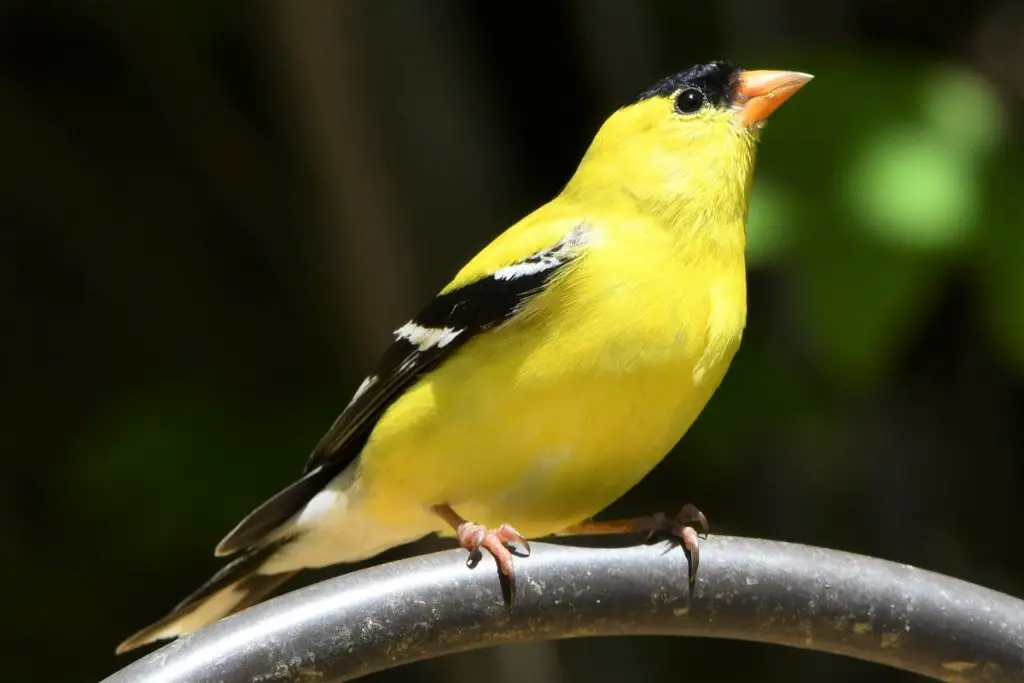
American Goldfinch summary:
Family: Fringillidae
Occurrence: Southern Canada to California in the summer. Also Florida and Mexico in winter.
Diet in the wild: Seeds, insects.
Feeder type preferences:
- Large tube feeder
- Small tube feeder
- Ground feeder
- Large hopper feeder
- Small hopper feeder
- Platform feeder
Feeder food preferences:
- Black Oil Sunflower Seeds
- Hulled Sunflower Seeds
- Nyjer (Thistle) seeds
Endangered: No.
The American goldfinch is a small garden bird commonly found in large flocks throughout the US, southern Canada, and central Mexico. As short-distance migratory birds, they move south during the winter to escape the cold.
During summer they are found from southern Canada to California and North Carolina. During winter, they can be found from Washington to Nova Scotia south into central Mexico. Their natural habitat is open meadows, but they often flock towards bird feeders in suburban areas. They are the official state bird of three US states: Iowa, New Jersey, and Washington.
The American goldfinch belongs to the Fringillidae (finch) family. There are four subspecies: the eastern goldfinch, the pale goldfinch, the northwestern goldfinch, and the willow goldfinch. Other closely related species include the lesser goldfinch, Lawrence’s goldfinch, and the siskins. Despite the similar sounding name, they are not related to the European goldfinch.
Identifying the American goldfinch
The American goldfinch is a 4 to 6-inch, brown to yellow bird with a white undertail. Their wings and tail are black with white markings. In summer, the male is easily distinguishable with his bright yellow plumage and black cap. The female has a pale-yellow underside in the summer months with an olive-colored head and back. In winter, both males and females are olive-brown with a yellowish head. Juveniles are a dull brown with pale yellow undersides. Their call is a chirpy “tsee-tsi-tsi-tsit”.
Subspecies can be distinguished by their distribution and small variations in coloration and size. The eastern goldfinch is the most common and most eastern subspecies. They occur from Colorado eastwards from southern Canada to central Mexico.
The slightly larger pale goldfinch, as its name suggests, has a paler body, stronger white markings, and a larger black cap in the male. They have a more western range stretching from British Columbia to western Ontario south to Mexico.
The northwestern goldfinch is darker and smaller compared to the other subspecies. They occur along the coastal slope of the Cascade Mountains from southern British Columbia to central California. The willow goldfinch has a browner winter plumage, and in summer, males have a smaller black cap. They are found to the west of the Sierra Nevada range in California southwards into Baja California.
The male lesser goldfinch could be confused with the male American goldfinch but their cheeks and back are olive to black instead of yellow and the black crown of the male covers its entire head. In both males and females, the lesser goldfinch has a yellow undertail, instead of white. The Lawrence’s goldfinch male has a black face and yellow breast, but the rest of its body is grey. Females of Lawrence’s goldfinch have a grey head and back, whereas the American goldfinch has a yellow head and olive back.
Breeding and feeding of Goldfinches
The American goldfinch’s diet consists entirely of seeds. Their breeding season starts in June, when seeds are in greatest supply. Monogamous pairs nest in trees or shrubs. Their nest is an open cup of three inches, woven from plant fibers, bound by spiderwebs and caterpillar silk, and lined with plant down. They will lay four to six eggs, each less than an inch long, pale bluish white, with occasional brown spots.
Attracting the American goldfinch to your backyard
To attract the American goldfinch, you can put out various seeds (especially sunflower and nyjer seeds), and beet greens. Use a feeder designed for smaller birds, because large birds at the feeder could discourage the American goldfinch. During the breeding season, you can put out 100% cotton for them as nesting material. Plant indigenous grasses, sunflowers, thistles, dandelions, coneflowers, milkweed, zinnias, and large trees in your garden. A bird bath or water feature would provide an additional attraction.
Is the american goldfinch endangered
The American goldfinch is listed as least concern since its population is generally increasing across the United States. However, climate change could cause southern contractions in their distribution with local extinctions in various states, due to the increased risks of heatwaves and heavy rainfall endangering their eggs and chicks.
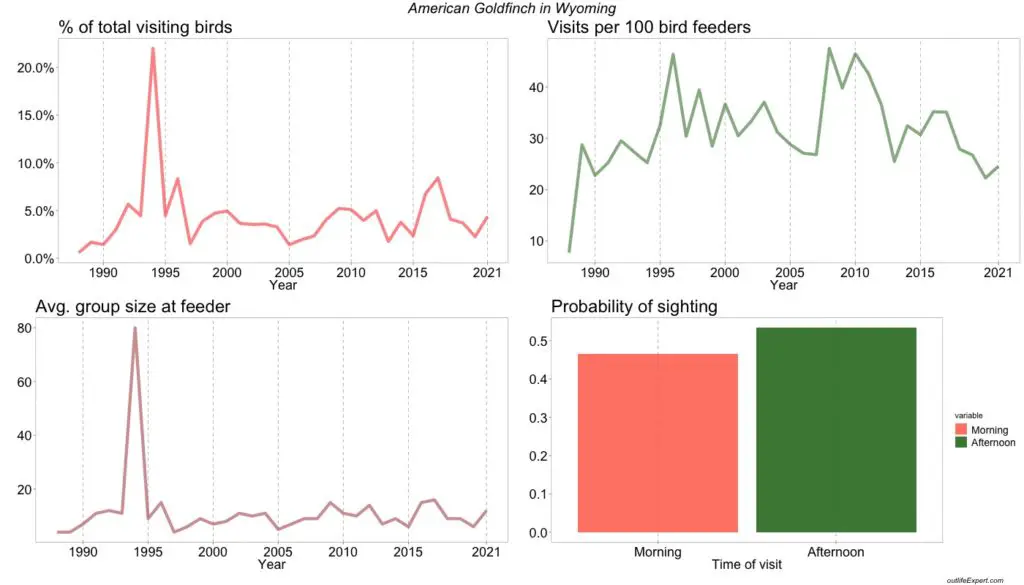
% of total visiting birds: The proportion of the specific bird out of the total number of birds observed bird feeders in this state.
% of total feeders visited: The proportion of feeders (out of all participating feeders in the state each year) where the bird was observed at least once within 2 days.
Avg. group size at feeder: The average number of birds counted simultaneously for each bird feeder observation.
Probability of sighting: The chance of spotting the bird in either morning (before 12 noon) or afternoon (after 12 noon). If both are 0.5 there is an equal chance of spotting the bird in the morning and afternoon.
White-breasted Nuthatch (Sitta carolinensis) in Wyoming
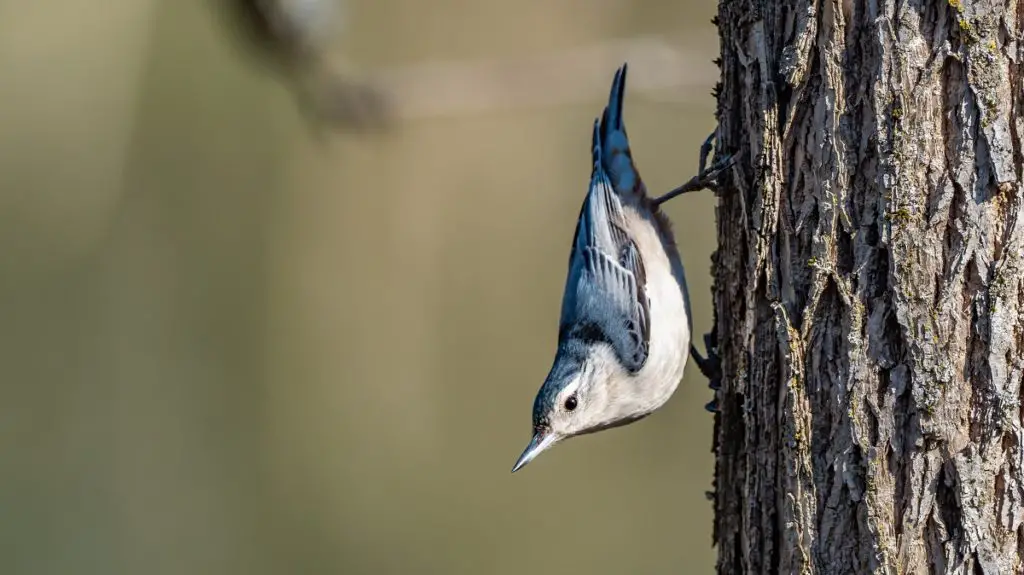
Family: Sittidae
Occurrence: Throughout United States, Canada, and Mexico when forest is present.
Diet in the wild: Insects in the summer, seeds in the winter.
Feeder type preferences:
- Large tube feeder
- Small tube feeder
- Suet Cage
- Large hopper feeder
- Small hopper feeder
- Platform feeder
Feeder food preferences:
- Suet
- Black Oil Sunflower Seeds
- Hulled Sunflower Seeds
- Safflower
- Mealworms
- Crushed peanuts
- Whole peanuts
Endangered: No.
The white-breasted nuthatch is a common garden bird in western Canada, large parts of Mexico, and most of the US (except for Alaska).
They get their common name from their white breast and their habit to wedge a food item in a crevice and hack them open with their strong bills. They are mostly found in monogamous pairs, but during winter they will sometimes flock with other bird species. They belong to the nuthatch family, Sittidae, and are closely related to wallcreepers, treecreepers, wrens, and gnatcatchers.
There are three other nuthatches in North America: the red-breasted nuthatch, the brown-headed nuthatch, and the pygmy nuthatch.
Identifying the white-breasted nuthatch
White-breasted nuthatches are 5 to 6 inches, have a large head, short tail and wings, and a strong bill and feet. They have blue-grey upperparts with white underparts and face and a black cap extending down to a black bar across the nape of its neck.
They have black and white markings on their wings and tail and a rust-colored undertail.
Females have a slightly narrower nape band, and their coloring is slightly less contrasted than that of the male and their cap is sometimes grey. However, it is often difficult to distinguish males from females in the field.
Juveniles have duller plumage than the adults. They have a wide repertoire of vocalizations, but their most distinctive vocalization is a “Kri-Kri-Kri-Kri” call. There are nine subspecies of white-breasted nuthatch, all visually similar with only slight variations in color, size and bill shape.
None of the other nuthatches in North America have a completely white face. The red-breasted nuthatch has a black eye line, white brow, and a reddish breast. Both the brown-headed nuthatch and the pygmy nuthatch are smaller and have a brown cap instead of black. In the black-capped chickadee, the black cap covers its eyes, and it has a black bib.
Where and when does the white-breasted nuthatch nest
The white-breasted nuthatch breeds in woodland habitats across North America. Their breeding season is between May and June. The male performs a courtship ritual where he spreads his tail, droops is wings and bows to the female while he sways back and forth.
They use natural cavities or old woodpecker nests in trees for nesting. They form a cup of bark, grasses, twigs, and hair. They will lay five to nine eggs, each less than an inch long, cream colored with brown speckles.
In summer, they eat mostly insects, but in winter, when insects are in short supply, they supplement their diet with seeds and nuts. Their chicks feed almost exclusively on insects.
During autumn and winter, they will stash food from bird feeders in bark crevices for later use.
How to attract the white-breasted nuthatch to your garden
The white-breasted nuthatch will visit birdfeeders for sunflower seeds, peanuts, suet, and mealworms.
In your garden you can plant large trees such as oak, beech and hickory to provide food and potential nesting sites.
Create an insect-friendly garden with lots of indigenous plants and shrubs, a thick mulch layer and dead logs.
Do not use insecticides in your garden. Insecticides not only kill the insects that birds feed on, but could also result in secondary poisoning when birds eat poisoned insects.
Is the white-breasted nuthatch endangered
The white-breasted nuthatch is listed as least concern, since its population is increasing. However, forest clearance and the removal of dead trees can lead to reduced numbers locally, but may lead to more white-breasted nuthatches to seek towards backyards and birdfeeders in cities.
Their natural predators include birds of prey and snakes. Squirrels compete with nuthatches for tree cavities and will eat their chicks and eggs. Despite these threats, the white-breasted nuthatch is doing quite well in Wyoming.
The increased threat of wildfires and spring heat waves due to climate change is causing a northward range shift, which could cause them to go locally extinct in the southern states of their distribution.
From the graph below, you will see that the white-breasted nuthatch is actually getting increasingly more common at bird feeders in Wyoming. However, this does not necessarily mean that its general population is increasing. It could also mean that the nuthatches seek from the forest towards the cities to obtain food. Either because their habitats are disappearing or simply because backyards are getting more attractive, e.g having more trees or bird feeders, for the nuthatches to enjoy.
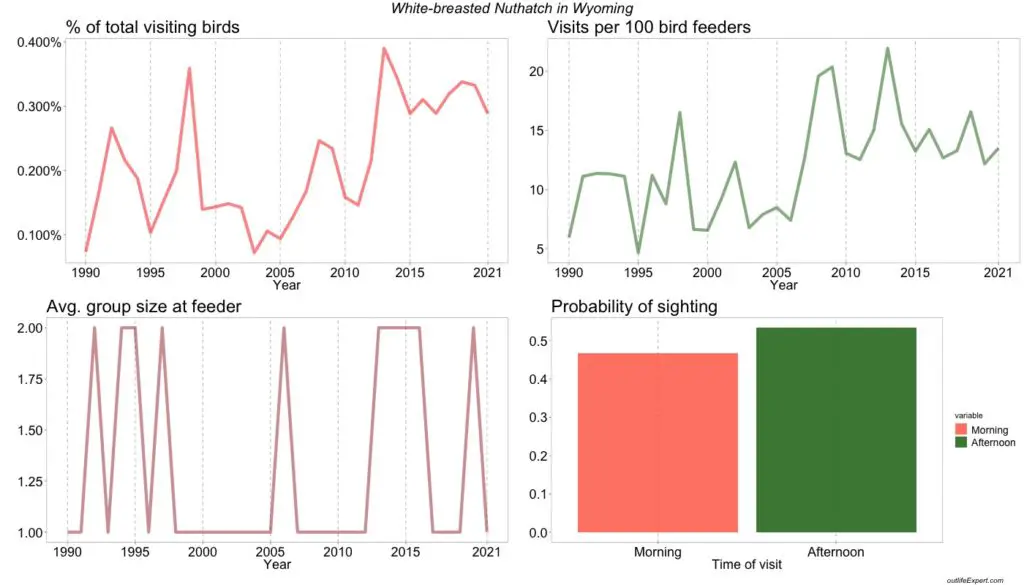
% of total visiting birds: The proportion of the specific bird out of the total number of birds observed bird feeders in this state.
% of total feeders visited: The proportion of feeders (out of all participating feeders in the state each year) where the bird was observed at least once within 2 days.
Avg. group size at feeder: The average number of birds counted simultaneously for each bird feeder observation.
Probability of sighting: The chance of spotting the bird in either morning (before 12 noon) or afternoon (after 12 noon). If both are 0.5 there is an equal chance of spotting the bird in the morning and afternoon.
American Robin (Turdus migratorius) in Wyoming
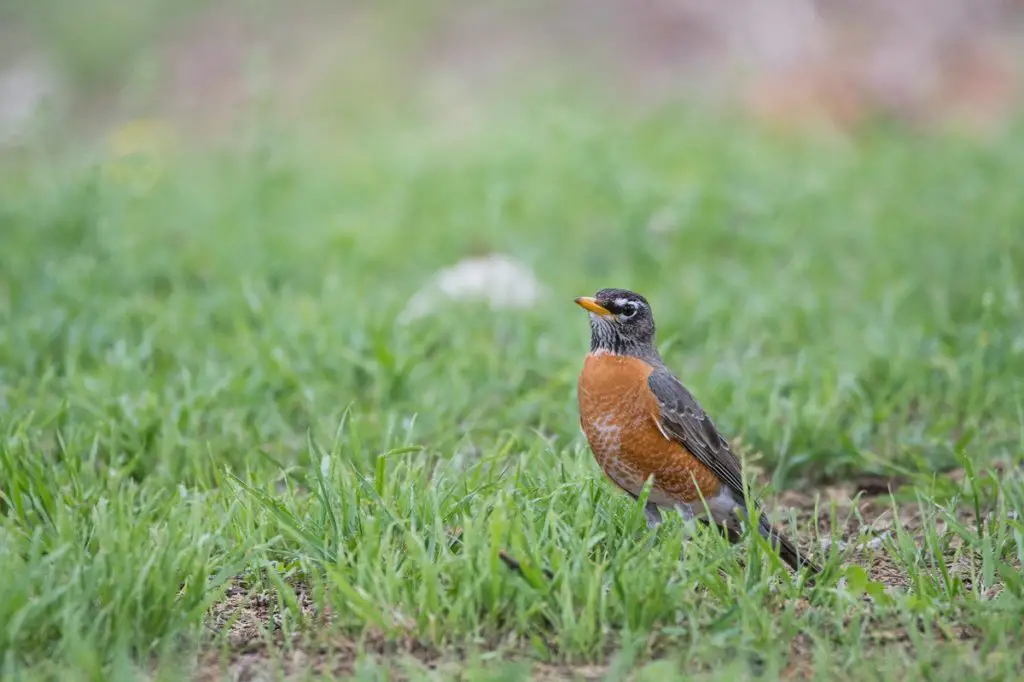
Family: Turdidae
Occurrence: Throughout North America, Canada and Mexico.
Diet: Insects in summer, fruits in winter.
Feeder type preferences:
- Ground feeder
- Platform feeder
Feeder food preferences:
- Crushed peanuts
- Fruits
- mealworms
- Suet
- Hulled Sunflower Seeds
Endangered: No.
The American Robin is a member of the Thrush genus and is one of the most common birds in the United States and can be found in all regions and also in Canada. They will often be seen wandering across a newly-cut garden lawn looking for an earth worm to eat and they are instantly recognizable. There are seven-subspecies of American Robin.
Where does the American Robin come from
The American Robin is found in all regions – as far north as Alaska, but it is a migratory bird and will leave Canada and other colder areas in the fall and head south. Its migration is usually triggered by food levels.
How and where to spot the American Robin
This species of bird can be found in rural areas, open woodland, towns and cities. It measures 8-11 inches in length (20-28 cm) and has a wingspan of 12-16 inches (30-41 cm) The American Robin has a distinctive reddish orange breast, which is a stronger color in the male than female, but otherwise the sexes are very similar. The rest of its body is a grayish brown color with a black cap and it has long legs and pale yellow bill. Around its eyes there are white spots that form a broken ring.
The American Robin is usually the bird to start the dawn chorus and has a high-pitched call but also a very melodic song. It will happily sing all day long and will be one of the last birds to roost in the evening.
Habitat and mating of the American Robin
This Robin is happy to live in a variety of habitats and forms large roosts often of several thousand birds. The roosts are predominantly male Robins as the females stay in the nest caring for the young, but once they have flown the nest, the female will join the roost.
American Robins like to nest in trees and shrubs. They build their nest from tough grasses, twigs and feathers and they then line the nest with softer grasses that they stick in place using wet mud. They have up to three broods each year and are one of the first birds to lay their eggs. There are usually four eggs but often only one of the young birds in each brood will survive to maturity. The young birds are spotted like thrushes. These birds regularly live six years.
What does the American Robin eat and how can you attract it
The American Robin is a ground forager and loves nothing better than a pile of dead leaves to rummage for insects. It has a wide diet, but during the winter months eats almost solely berries. The American Robin is a frequent visitor to bird feeders and enjoys suet, sunflower seeds, fruit, peanuts, berries – and earthworms. If you want to try and attract a breeding pair, it is worth fixing a nesting box on the trunk of a tree.
The preferred foods of American Robin
- earthworms
- insects
- caterpillars
- berries
- fruit
Many people enjoy seeing the first robins of the year as they feel that spring is on its way. Luckily American Robins are one of the most numerous birds in the United States and its numbers are rapidly increasing in Wyoming (see graph below)!
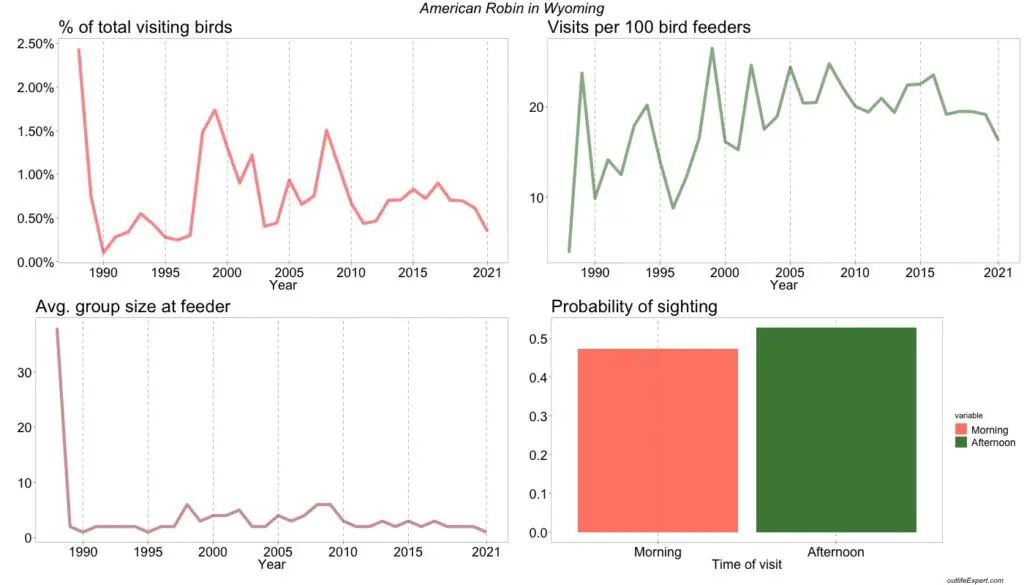
% of total visiting birds: The proportion of the specific bird out of the total number of birds observed bird feeders in this state.
% of total feeders visited: The proportion of feeders (out of all participating feeders in the state each year) where the bird was observed at least once within 2 days.
Avg. group size at feeder: The average number of birds counted simultaneously for each bird feeder observation.
Probability of sighting: The chance of spotting the bird in either morning (before 12 noon) or afternoon (after 12 noon). If both are 0.5 there is an equal chance of spotting the bird in the morning and afternoon.
Backyard birds in other states
Are you interested in how the backyard birds in your state compare to other states?
Then check out my other blog posts below:
- Backyard birds of Alabama
- Backyard birds of Colorado
- Backyard birds of Delaware
- Backyard birds of Georgia
- Backyard birds of Hawaii
- Backyard birds of Illinois
- Backyard birds of Iowa
- Backyard birds of Kentucky
- Backyard birds of Louisiana
- Backyard birds of Maryland
- Backyard birds of Massachusetts
- Backyard birds of Missouri
- Backyard birds of Nebraska
- Backyard birds of New York
- Backyard birds of North Carolina
- Backyard birds of Oklahoma
- Backyard birds of Rhode Island
- Backyard birds of South Carolina
- Backyard birds of Tennessee
- Backyard birds of Texas
- Backyard birds of Virginia
- Backyard birds of West Virginia
- Backyard birds of Wisconsin
- Backyard birds of Wyoming
And in Canada:
- Backyard birds of Ontario
- Backyard birds of Prince Edward Island
- Backyard birds of Saskatchewan
- Backyard birds of Quebec
Not on the list? Check out the rest of my posts on backyard birds here!
Maybe you would like to know if the Blue Jay or Cardinal dominates in the bird feeder hierarchy or how birds such as seagulls sleep at night? Or why mourning doves poop so much and whether most birds can poop and fly at the same time!
A lightweight handy pair of binoculars is a must for your backyard bird watching! Check out my recent post on the best small lightweight binoculars for birdwatching etc.
My Favorite Backyard Birding Gear:
- Photographs and identifies birds coming to your bird feeder!
- Notifies you via the app whenever a bird stops by!
- Excellent resolution and battery performance with the 6MP image sensor.
- Connect from anywhere with internet access (watch birds even when you are not at home!)
- Count the birds visiting your feeder and contribute to projects such as FeederWatch!
If you are interested in posters and other wall arts etc. with drawings of all the backyard birds you have just read about, check out my portfolio over at Redbubble:
Acknowledgements
I want to thank the Cornell Lab of Ornithology at Cornell University and the Birds Canada organization as well as all the citizens who have been involved in the FeederWatch project for providing the data of this article. The data I have used to generate the prevalence numbers for this article is provided by the FeederWatch project. The FeederWatch project is an initiative by The Cornell Lab of Ornithology at Cornell University and the Birds Canada organization. The data is collected through an immense crowdsourced citizen science program, where citizens of the United States and Canada are invited to count birds at their bird feeders, identify the species, and report back to the scientists at Cornell University. The birds are counted from November to April and always in two consecutive days including only one area with a bird feeder, typically a piece of the backyard, observed from one vantage point. The two-day watch is then repeated throughout the season. The data is collected each year and is freely available to the public at https://feederwatch.org/.
References
American Museum of Natural History Birds of North America. DK; Revised edition (September 6, 2016). ISBN: 978-1465443991
National Geographic Backyard Guide to the Birds of North America, 2nd Edition. National Geographic; 2nd edition (October 15, 2019)
Birds of North America. National Audubon Society. (Knopf April 6, 2021). ISBN: 978-0525655671

